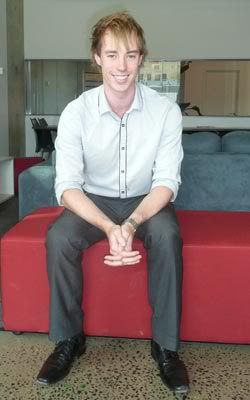Support for rural students, by rural students
Year 3 Monash medical student, William Goss, with support from his peers, has taken up the challenge of establishing a program that encourages a better relationship between medical students and the health service in their home town or region. The idea is to create a relationship that encourages students to return to their home area once they have graduated.
William, who is from Sale in East Gippsland, explains in the following item how the Local Rural Medical Students (LRMS) concept works.

Year 3 student, William Goss, has set up a support network to link rural students with health services in their home regions.
The aim of the LRMS project is to develop a relationship between local medical students and their hometown health service and medical staff. We hope that by forging such relationships, there may be an increased incentive for the students to return at completion of their degree.
The LRMS program should give the students access to local medical library, postgraduate educational activities, and local clinical placements throughout their time at university. It fosters a collegiate relationship between local medical students at various year levels who may act as mentors and provide peer support.
In addition, LRMS seeks to encourage local secondary students to pursue a career in medicine. This is through accessibility to a formalized peer group of similar age who may provide information about course entry or about the course itself.
Currently there is no formal liaison/relationship developed between rural students who successfully achieve a place in MBBS and their hometown health service or local service providers. My LRMS concept is based upon the need for the local community to attract local students back to their local area where there is already a great need for culturally aware and locally trained health professionals. Part of this should be a celebration of one of their own community members striving for a university education and who is going to practice medicine.
Presently little is done by regional health services to facilitate such a process. Therefore, with the encouragement of my local peer group, I have taken the onus to encourage this relationship. The local Monash University Regional Clinical School has happily embraced the project, which is in its initial stages but hopefully over the following 6-12 months we can fully incorporate all local students and successfully get the project running.
Earlier this year the local Gippsland students involved in the LRMS project organised a welcome session for five secondary students from the local area who had received a place at medical schools across the country. Another third year medical student, Saada Malouf, and I spoke to the students about what to expect at both university and at college, as well as giving any useful tips that we could.
Helen Ried, Central Gippsland Health Service librarian, spoke about the Library and its role in medical education and services providing support for local students. Students were registered for library use which enables access to the facility and resources. The students were also shown through the Rural Medical School facilities and given various means to contact us if they need any help throughout the year. We plan to have further study sessions and OSCE practice sessions with these students towards the end of the year, closer to exams.
Upon graduation, I intend to pass the LRMS project on to an earlier year student. My peers hope the group can grow and develop further to cover all levels of students, past students from the area and more local practitioners.
We would like the LRMS set up in other regional areas of Australia. This would be beneficial for the attraction and retention of rural students to improve the rural Australian health network.
– William Goss, Year 3 medical student Monash University